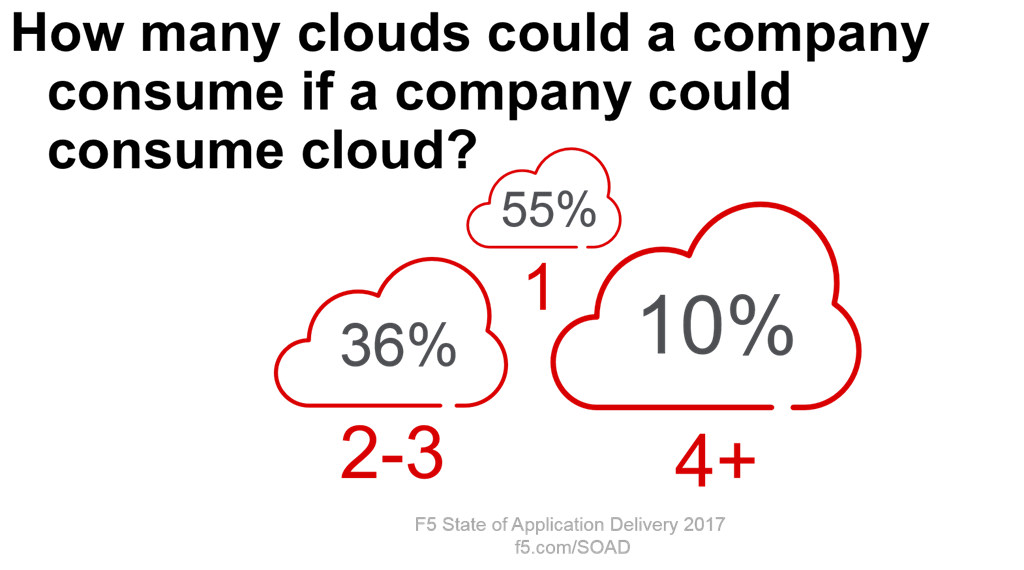Es gibt nur zwei Arten von Wolken: Die, die Sie kontrollieren und die, die Sie nicht kontrollieren
Cloud-Einblicke aus dem State of Application Delivery 2017
Kontrolle. Wir verwenden dieses Wort häufig. Beherrsche dich! Kontrollieren Sie Ihr eigenes Schicksal! Kontrollieren Sie Ihre finanzielle Zukunft. Finden Sie heraus wie!
Kontrolle ist ein einfaches Wort mit einer sehr mächtigen Bedeutung: die Zügel in die Hand zu nehmen und zu bestimmen, wo und wie etwas geschieht.
Im Unternehmensbereich erleben wir, dass das Konzept der Kontrolle ein wichtiger Faktor ist, wenn es um die Cloud geht. Für manche mag das überraschend sein. Bei anderen – insbesondere bei denen, die in den vergangenen zehn Jahren mitgelesen haben – ist das vielleicht nicht der Fall. Unabhängig davon besteht die Realität darin, dass Unternehmen Cloud-Modelle bevorzugen, die sie kontrollieren können, gegenüber solchen, die sie nicht kontrollieren können. Das bedeutet nicht, dass es sich nicht um Cloud-Modelle handelt , die größtenteils auf der Kommerzialisierung von Ressourcen (IaaS) oder Funktionen (SaaS) basieren. Es bedeutet nur, dass sie dazu neigen, zuerst andere Modelle zu wählen, was teilweise durch die Art der eingesetzten Anwendungen bedingt ist.

Als wir weltweit über 2.100 IT-Experten aus allen Branchen und in allen Funktionen der IT-Branche zur Nutzung unterschiedlicher Cloud-Modelle in ihren Unternehmen befragten, deuteten die Ergebnisse mit überwältigender Mehrheit auf eine Präferenz für Modelle hin, die mehr Kontrolle ermöglichen.
Es geht hier nicht um den Standort, wohlgemerkt. Während die Befragten die lokale Private Cloud klar bevorzugten, war es nicht ohne Bedeutung, dass auch die Colo Cloud und die Off-Premises Private Cloud – die beide auf der Bereitstellung von Apps und Infrastruktur außerhalb des Standorts basieren – als in Gebrauch gekennzeichnet wurden. Häufiger als andere „öffentliche“ Modelle: IaaS und PaaS. Und natürlich erfreut sich SaaS weiterhin großer Beliebtheit bei Unternehmen aller Größen und Branchen. Auch alles außerhalb des Firmengeländes.
Es ist also nicht der Standort , der den Unternehmen Probleme bereitet, sondern vielmehr die zwangsläufigen Einschränkungen bei Sichtbarkeit und Kontrolle aufgrund von Modellen, die weitgehend auf dem Konzept der Kommerzialisierung basieren.
Die Kommerzialisierung bringt ein hohes Maß an Standardisierung mit sich, und die Standardisierung schränkt Abweichungen ein. Eine Anpassung ist möglicherweise möglich, jedoch nur auf Anwendungsebene. Die Infrastruktur und damit ein großer Teil der Architektur sind für die Abonnenten solcher Dienste unantastbar.
Und das aus gutem Grund. Würde jeder beispielsweise an den Netzwerkschichten von Amazon oder Azure herumbasteln, hätte dies verheerende Folgen für das gesamte System und würde steigende Kosten verursachen, die wahrscheinlich an die Kunden weitergegeben würden. Es käme zu Störungen und schließlich käme es bei benachbarten Anwendungen und Systemen zu Ausfällen (oder Schlimmerem), was den Wert der öffentlichen Cloud mindern und ihre Nutzung unrentabel machen könnte.
Die durch öffentliche Cloud-Modelle erzwungene Standardisierung ist notwendig und eine gute Sache. Es ermöglicht beispiellose Kosteneinsparungen, eine stabile Umgebung und ein konsistentes Erlebnis. Alles gute. Sofern Unternehmen nicht ein höheres Maß an Kontrolle wünschen, das auch die Schichten der Infrastruktur einschließt, die normalerweise vom Cloud-Anbieter abstrahiert und kontrolliert werden.
Dies ist wahrscheinlich der Grund, warum wir eine so hohe Nutzung „steuerbarer“ Cloud-Modelle beobachten. Als Reaktion auf das größere Kontrollbedürfnis von Unternehmen sind Off-Premises-Privatspeicher (denken Sie an Amazon VPC) schon seit langem verfügbar. Aber auch sie haben ihre Grenzen (aufgrund der Kommerzialisierung, verstehen Sie), weshalb sich die Colocation-Cloud in so kurzer Zeit zu einer so beliebten Option entwickelt hat. Indem sie das Bedürfnis nach Kontrolle mit der Wahl einer öffentlichen IaaS-Cloud kombinieren, haben Colocation-Cloud-Anbieter den richtigen Mix aus Kontrolle und Komfort gefunden, um Unternehmen ein weiteres Element im Menü des Cloud-Modells anzubieten.
Organisationen erfüllen diese konkurrierenden Anforderungen – bezahlbare, standardisierte Ressourcen und Funktionen versus vollständige Kontrolle – nicht mit einem einzigen Modell. Beachten Sie, dass die Prozentsätze in der Grafik zusammen mehr als 100 Prozent ergeben. Denn die Befragten wählten alle zutreffenden Modelle aus. Im Durchschnitt nutzen sie 1,8 Cloud-Modelle.

Wenn wir uns ansehen, wie viele unterschiedliche Modelle die Organisationen nutzen, stellen wir fest, dass fast die Hälfte (46 %) mehr als zwei Modelle nutzt. Nicht unerhebliche zehn Prozent nutzen vier oder mehr verschiedene Modelle, um diese unterschiedlichen Bedürfnisse zu erfüllen.
Und die Nutzung öffentlicher (IaaS-)Clouds nimmt zu. Die Ergebnisse unserer Umfrage deuten auf eine zunehmende Präferenz für die Bereitstellung aller Kategorien von App-Diensten in öffentlichen Clouds (IaaS) hin. Da man die besagten App-Dienste im Allgemeinen nicht ohne eine App zur Unterstützung, Sicherung oder Bereitstellung einsetzt, kann man mit Sicherheit davon ausgehen, dass die App-Bereitstellungen in öffentlichen (IaaS-)Clouds tatsächlich vergleichsweise zunehmen.
Daher gehe ich davon aus, dass die Anzahl der eingesetzten Cloud-Modelle in künftigen Umfragen entsprechend steigen wird. Dies liegt unter anderem an der Art der Anwendungen, die in den verschiedenen Modellen eingesetzt werden. Einweg-Apps, erneuerbare Apps, mobile Apps und dergleichen eignen sich aufgrund der Zugänglichkeit, Skalierbarkeit und des Kostenmodells von Natur aus gut für die öffentliche Cloud. Dies spiegelt sich auch in unseren Ergebnissen wider (falls Sie noch kein Exemplar erhalten haben, können Sie dies gleich hier tun), und zwar in den von den Befragten angegebenen Bereitstellungspräferenzen für Anwendungen.
Dies alles bedeutet, dass wir in ein Zeitalter der Multi-Cloud eintreten. Zwar verwenden 55 % der Befragten immer noch nur ein Cloud-Modell (und dieses ist größtenteils privat vor Ort), doch das ändert sich schnell, da Unternehmen immer schneller andere Cloud-Modelle übernehmen. Tatsache bleibt jedoch, dass Unternehmen ihre Cloud-Anbieter auch weiterhin sorgfältig auswählen werden. Dabei kommt es vor allem darauf an, ob sie Kontrolle über ihre gesamte Architektur benötigen oder nicht.
Es mag zwar viele Cloud-„Modelle“ geben, aber letzten Endes gibt es wirklich nur zwei Arten von Clouds: solche, die Kontrolle bieten, und solche, die auf der Prämisse der Kommerzialisierung basieren. Und die Unternehmen verbrauchen beides in großen Mengen.
